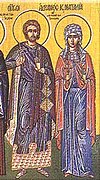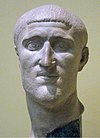Deaths
|
Transcluding articles: 300, 301, 302, 303, 304, 305, 306, 307, 308, and 309 |
300
- Jia Mi, Chinese general, official and politician
- Jia Nanfeng, Chinese empress of the Jin Dynasty (b. 257)
- Liu Ling, Chinese scholar and poet (b. 221)
- Lüzhu, Chinese dancer, singer and music teacher
- Pan Yue, Chinese poet and writer (b. 247)
- Pei Wei, Chinese philosopher and politician (b. 267)
- Shi Chong, Chinese politician and statesman (b. 249)
- Sima Yu, Chinese prince of the Jin Dynasty (b. 278)
- Sporus of Nicaea, Greek mathematician (approximate date)
- Zhang Hua, Chinese official, scholar and poet (b. 232)
301
- June 5 – Sima Lun, Chinese usurper (forced suicide)
- Sun Xiu (or Junzhong), Chinese official and politician
302
- Cao Huan, Chinese emperor of the Cao Wei state (b. 246)
- Narseh (or Narses), ruler of the Sassanid Empire
- Sima Jiong (or Jingzhi), Chinese prince and regent
303

- April 23 – George of Lydda, Roman soldier and martyr
- Acacius of Byzantium, Roman centurion and martyr
- Anthimus of Rome, Christian priest and martyr
- Cao Huan, Chinese emperor of Cao Wei (b. 246)
- Cessianus, Christian child martyr
- Crescentinus, Roman soldier and martyr
- Cyriacus, Roman nobleman and martyr
- Devota, Corsican woman and martyr
- Erasmus of Formiae, Christian martyr
- Expeditus, Roman centurion and martyr
- Felix and Adauctus, Christian martyrs
- Fermin, Christian bishop and martyr
- Lu Ji, Chinese general and writer (b. 261)[20]
- Li Liu, Chinese spiritual leader (b. 248)
- Li Te (or Xuanxiu), Chinese general
- Pantaleon, Christian wonderworker and martyr
- Romanus of Caesarea, Christian martyr
- Victor Maurus ("the Moor"), Christian martyr
- Vitus (or Guido), Christian martyr
304


- October 25 – Pope Marcellinus
- December 25 – Saint Anastasia (martyred)
- Date unknown
- Saint Afra (martyred by fire)
- Saint Agape, Chionia, and Irene (martyred)
- Saint Agnes (martyred)
- Saint Alban (possibly 309)
- Bunseo of Baekje, king of Baekje (Korea)[21]
- Saint Florian (martyred)
- Saint Gorgonius of Nicomedia (martyred)
- Saint Juliana of Nicomedia (martyred)
- Saint Lucy of Syracuse (martyred)
- Saint Margaret (martyred)
- Saint Pancras (martyred)
- Saint Philomena (martyred)
- Sima Ai, Chinese prince of the Jin dynasty (b. 277)[22]
- Saints Theodora and Didymus (martyred)
- Saint Vincent of Saragossa (martyred)
305
- Januarius I of Benevento, Roman bishop and martyr
- Catherine of Alexandria, Christian martyr and virgin
- Porphyry of Tyre, Neoplatonist philosopher and writer
- Proculus of Pozzuoli (or Proclus), Christian martyr
- Sossianus Hierocles, Roman proconsul and aristocrat
- Tuoba Yituo, Chinese chieftain of the Tuoba clan
- Vincent, Orontius, and Victor, Christian martyrs
- Wang Rong (or Junchong), Chinese politician (b. 234)
- Zuo Si (or Taichong), Chinese poet and writer (b. 250)
306




- February 17 – Theodore of Amasea, Roman soldier and martyr
- March 4 – Adrian and Natalia of Nicomedia, Christian martyrs
- July 25 – Constantius Chlorus, Roman emperor (b. c. 250)
- August 25 – Maginus, Christian hermit and martyr
- Demetrius of Thessaloniki, Roman soldier and martyr
- Sima Ying, Chinese prince of the Jin Dynasty (b. 279)
- Sima Yong (or Wenzai), Chinese prince and regent
307

- January 8 – Hui of Jin, Chinese emperor of the Jin Dynasty (b. 259)
- September 16 – Severus II, Roman emperor (murdered)
- Septimius of Iesi, German bishop, martyr and saint
- Tuoba Luguan, Chinese chieftain of the Tuoba clan
308
- Adrian of Batanea (or Eubulus), Christian martyr
309
- January 16 – Marcellus I, bishop of Rome (b. 255)
- Adur Narseh, king of the Sassanid Empire
- Elias and companions, Christian martyrs
- Hormizd II, king of the Sassanid Empire